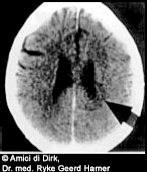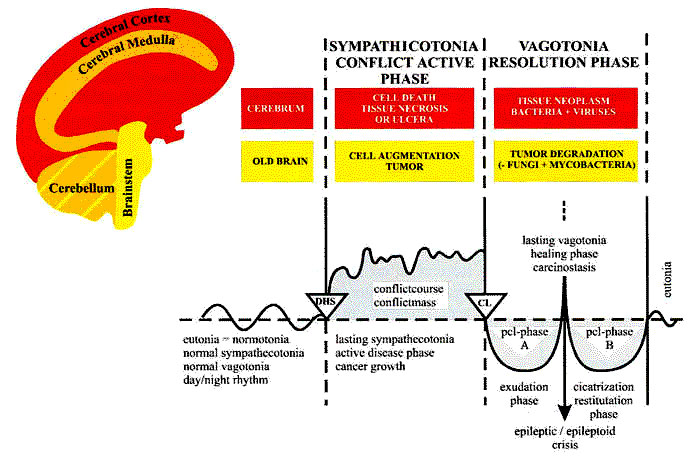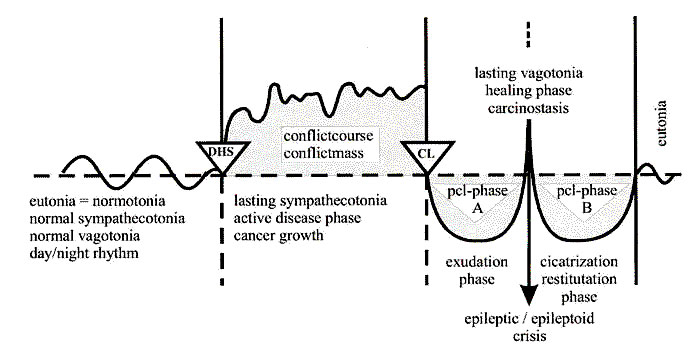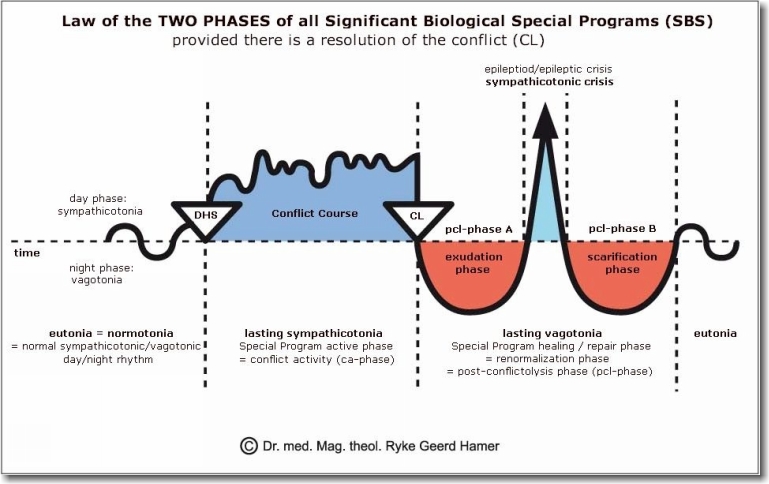|
Vancouver, Canada
This article was
first published in: EXPLORE! Vol. 6 /Nr. 3 - May 2007
But Dr. Hamer took his research a momentous step further. Pursuing the hypothesis that all bodily events are controlled from the brain, he analyzed his patients’ brain scans and compared them with their medical records. Dr. Hamer discovered that every disease—not only cancer!—is controlled from its own specific area in the brain and linked to a very particular, identifiable, “conflict shock”.
The result of his
research is a scientific chart that illustrates the biological
relationship between the psyche and the brain in correlation with
the organs and tissues of the entire human body (the English
“Scientific Chart of GNM” is in the works).
(In response to the
growing number of misrepresentations of his discoveries and to
preserve the integrity and authenticity of his scientific work, Dr.
Hamer has now legally protected his research material under the name
German New Medicine (GNM). The term “New Medicine”
could not be copyrighted internationally).
By 1987 he was able to extend his
discoveries to practically every disease known to medicine.
But as long as the University of Tübingen’s medical faculty maintains its delay tactics, patients all
over the world will be denied the benefit of Dr. Hamer’s
revolutionary discoveries.
Psychologically
speaking, a DHS is a very personal incident conditioned by our past
experiences, our vulnerabilities, our individual perceptions, our
values and beliefs. Yet, a DHS is not a merely psychological but
rather a biological conflict that has to be understood in the
context of our evolution.
A male, for instance,
can suffer a “territorial loss conflict” when he unexpectedly loses
his home or his workplace; a female “nest conflict” may be a concern
over the well-being of a “nest member”; an “abandonment conflict”
can be triggered by an unforeseen divorce or by being rushed to the
hospital; children often suffer a “separation conflict” when Mom
decides to go back to work or when the parents split up.
Upon impact, the affected brain cells communicate the shock to the corresponding organ, which in turn responds with a particular— predictable!—alteration.
The reason why specific
conflicts are indissolubly tied to specific brain areas is that
during our historical evolution, each part of the brain was
programmed to respond instantly to conflicts that could threaten our
survival. While the “old brain” (brain stem and cerebellum) is
programmed with basic survival issues that relate to breathing,
eating, or reproduction, the “new brain” (cerebrum) is encoded with
more advanced themes such as territorial conflicts, separation
conflicts, identity conflicts, and self-devaluation conflicts.
GNM’s “Ontogenetic
System of Tumors” illustrates that “old-brain”-controlled organs,
which derive from the endoderm or the “old-brain”-mesoderm, like the
lungs, liver, colon, prostate, uterus, corium skin, pleura,
peritoneum, pericardium, breast glands, etc., always generate cell
proliferation as soon as the corresponding conflict occurs. Tumors
of these organs therefore develop exclusively during the
conflict-active phase (initiated by the DHS).
With the shock of the death-fright the lung alveoli cells, which regulate breathing, instantly start to multiply, forming a lung tumor. Contrary to the conventional view, this multiplication of lung cells is not a pointless process but serves a very definite biological purpose, namely, to increase the capacity of the lungs and thereby optimize the organism’s chance of survival.
Dr. Hamer’s brain scan analyses demonstrate that every person with lung cancer shows a distinct target ring configuration in the corresponding area in the brain stem, and that each patient had suffered an unexpected death panic prior to the onset of cancer. In the majority of cases the death scare was triggered by a cancer diagnosis shock that the person experienced as a “death sentence”.
Given that smoking is on
the decrease, this sheds new light on the enigmatic increase of lung
cancer (“The #1 Killer”) and calls into question whether smoking is
per se an actual cause of lung cancer.
During the
conflict-active stress phase, the breast gland cells continually
multiply, forming a tumor. The biological purpose of the cell
proliferation is to be able to provide more milk for the suffering
offspring and thus speed up healing. Every female human and mammal
is born with this age-old biological response program. Dr. Hamer’s
many case studies show that women, even when not breast feeding,
developed a tumor in the breast glands from obsessively worrying
about the well-being of a loved one (a child who is in trouble, a
parent who is ill, or a dear friend who is a cause for concern).
The moment the conflict
occurs, the biologically corresponding organ tissue responds with
cell degeneration. Necroses of the ovaries or testicles,
osteoporosis, bone cancer, or stomach ulcers, for example, are
conditions that only occur while a person is in a state of emotional
distress in regards to the related conflict. As is to be expected,
the tissue loss has a biological significance.
A female mammal can suffer such a conflict when her offspring is lost or killed. As a natural reflex to the conflict the tissue of the milk duct lining starts to ulcerate. The purpose of the tissue loss is to increase the diameter of the ducts, because with enlarged ducts the milk that is no longer used can drain off easier and doesn’t get congested in the breast.
Every woman’s brain is programmed with this biological response. Since the female breast is, biologically speaking, synonymous with caring and nurturing, women suffer such a conflict by unexpected separation from a loved one they intensely care for.
There are virtually no
physical symptoms during the conflict-active phase, except
occasional light “pulling” in the breast.
While a meaningful cell alteration runs its course on the physical level, the psyche and the vegetative autonomous system also try to handle the unexpected situation.
Switched into a stress state (sympathicotonia), the mind becomes completely pre-occupied with the conflict contents. Sleep disturbances and lack of appetite are typical symptoms. Biologically speaking, this is vital, because the focus on the conflict and the extra waking hours provide the right conditions for working through the conflict and finding a resolution. The conflict-active phase is also called the “cold phase”.
Since the blood vessels
are constricted during stress, typical symptoms of conflict activity
are cold extremities (particularly cold hands), the shivers, and
cold sweats. The intensity of the symptoms is naturally dependent on
the magnitude of the conflict.
In German New Medicine
the distinction between “malignant” and “benign” cancers is entirely
meaningless. The term “malignant” is an artificial construct (the
same applies to tumor markers) that simply indicates that the
activity of cell reproduction has exceeded a certain arbitrary
limit.
When Dr. Hamer was arrested in 1997 for having given three people medical advice without a medical license, the police confiscated his patients’ files and had them analyzed. Subsequently, one public prosecutor was forced to admit during the trial that, after five years, 6,000 out of 6,500 patients with mostly “terminal” cancer were still alive. With conventional treatment the figures are generally just the reverse.
According to epidemiologist and biostatistician Dr. Ulrich Abel (Germany),
During the healing phase
the appetite returns, but we are very tired (we might not even be
able to get out of bed). Rest and supplying the organism with
nutrients are essential while the body is trying to heal. The second
phase is also called the “warm phase”, as during vagotonia the blood
vessels are enlarged, causing warm hands, warm feet, and warm skin.
This is usually
accompanied with potentially painful swelling, caused by an edema
that protects the tissue while it is healing. Other typical repair
symptoms are hypersensitivity, itching, spasm (if muscle tissue is
involved), and inflammation. Examples of “diseases” that only occur
in the healing phase are: certain skin disorders, hemorrhoids,
laryngitis, bronchitis, arthritis, atherosclerosis, bladder or
kidney disorders, certain liver diseases, and infections (see
below).
As with “old-brain”-controlled cancers, the tumor growth is neither accidental nor meaningless since the cell proliferation stops as soon as the tissue is mended. Testicular cancer, ovarian cancer, lymphoma, non-Hodgkin’s lymphoma, various types of sarcoma, bronchial and laryngeal carcinoma, and cervical cancer are all of a curative nature and are exclusively phenomena of the healing phase.
Provided that the
healing process is not interrupted through medication or a conflict
relapse, these tumors eventually degrade during the completion of
the healing phase.
A woman doesn’t develop
breast cancer without a reason! Neither does she develop breast
cancer by coincidence in precisely her right or left breast.
There is always a
crossover relation from the brain to the body, because each
hemisphere of the brain (excluding the brain stem) directs the
opposite side of the body.
Concerning more advanced
conflicts (and brain regions), the hormone status also has to be
taken into account for an accurate assessment.
This, in brief, is what he found (Fourth Biological Law):
Their function during the repair phase is to decompose tumors that are now superfluous, e.g., lung tumors, colon tumors, kidney tumors, prostate tumors, uterus tumors, breast gland tumors, melanomas, and mesothelioma. Tubercular bacteria are essential for breaking down the buildup of “disposable cells” that proliferated for a biological reason during the conflict-active phase. If the required bacteria are not available, due to vaccination, overuse of antibiotics, or chemotherapy treatment, the tumor cannot disintegrate properly.
As a result, it stays in
place and encapsulates harmlessly. Detected in a routine check-up,
however, such an encapsulated growth can lead to a “cancer”
diagnosis and, potentially, new conflict shocks with new symptoms.
By understanding the biological laws of disease development this
prospect can be virtually eliminated.
Concerning the role of viruses, Dr. Hamer prefers to speak of “hypothetical viruses” since lately the existence of viruses is called into question.
This would be in line
with Dr. Hamer’s earlier findings that the reconstruction and
restoration process of ulcerated or necrotized tissue still occurs,
even if the tissue-related viruses are not present.
Microbes can, of course,
be transmitted, but they remain dormant until the person is in the
healing phase of the same type of conflict.
For example, a lung tumor cell, which is of endodermal origin, controlled from the brain stem (“old brain”), and which proliferates during the conflict-active phase cannot transform itself into a bone cell, which is of mesodermal origin, controlled from the cerebrum (“new brain”), and which deteriorates during a conflict-active decalcification process. In the scenario “lung cancer metastasizes into the bones”, the lung cancer cells would actually be creating a hole (i.e., cell meltdown!—the reverse of a cancer) in some bone in the body.
We also have to ask
ourselves why cancer cells rarely “spread” to the closest
neighboring tissue, e.g., from the uterus to the cervix. If cancer
cells travel via the blood stream, why is donated blood not screened
for cancer cells? Why are there not multitudinous tumors found in
the walls of the blood vessels of cancer patients?
Besides the fact that
the “chase” is far from over (as the article indicates), doesn’t
this imply that the “metastasis” hypothesis was misinforming the
public and was scaring millions of cancer patients to death for over
four decades?
As already mentioned, an
unexpected diagnosis of cancer, or being told that it is
“metastasizing” can trigger a death-fright (causing lung cancer) or
any other type of diagnosis-related shock, causing new cancers in
other parts of the body. In many cases these patients don’t make it
into the healing phase, because the severe state of stress weakens
them to a point where they have very little chance of surviving the
highly toxic chemotherapy treatment.
Dr. Hamer found that our bones are biologically linked to our self-esteem and our self-worth. Thus, being told one has a “life-threatening illness”, especially one that allegedly “spreads like wildfire” through the body, is equated with: “now I am useless”, and the bone(s), next to where we feel “useless” start to decalcify (in the case of breast cancer often in the area of the sternum or the ribs). Just as with a fractured bone, the purpose of the biological program (of the “disease”) appears at the end of the healing phase.
When the repair phase is
completed, the bone will be much stronger at that site, thus
assuring that we are better equipped for the eventuality of a new
“self-devaluation conflict”.
During this crisis, the entire organism is thrust briefly into a state of sympathicotonia, i.e., re-living the typical symptoms of the conflict-active phase such as cold sweats, cold extremities, a fast heartbeat, and nausea.
The intensity and duration of this
pre-programmed crisis is
determined by the intensity and the duration of the preceding
conflict. Heart attacks, strokes, asthma attacks, and epileptic
seizures are just a few examples of this crucial turning point. The
type of “crisis” always depends on the nature of the conflict and
the precise brain area involved.
Dr. Hamer established already in 1981 that a “brain tumor” is not a disease in itself, but symptomatic of a healing phase that runs parallel in the organ (controlled from the correlated area of the brain that is simultaneously undergoing the repair phase).
These symptoms are very predictable!
Dr. Hamer’s findings provide us—for first time in the history of medicine—with a reliable system that allows us not only to understand but also to predict the development and symptoms of each and every disease. This is real preventive medicine, an aspect of German New Medicine which can hardly be emphasized enough. True prevention requires an understanding of the real cause of a disease, and that is what Dr. Hamer’s research supplies in splendid detail.
By understanding the “Five Biological Laws” of the cause and healing process of disease we can free ourselves from the fear and panic that often come with the onset of symptoms.
This knowledge is more than power, it can save lives.
|

 About
the Author
About
the Author By
analyzing thousands of brain computer tomograms (CT)
in relation to his patient’s histories, Dr. Hamer discovered that
the moment a DHS occurs, the shock impacts a specific, predetermined
area in the brain, causing a “lesion” that is visible on a CT scan
as a set of sharp concentric rings (In 1989, Siemens, the German CT
scanner manufacturer, certified that these ring formations are not
artifacts of the equipment).
By
analyzing thousands of brain computer tomograms (CT)
in relation to his patient’s histories, Dr. Hamer discovered that
the moment a DHS occurs, the shock impacts a specific, predetermined
area in the brain, causing a “lesion” that is visible on a CT scan
as a set of sharp concentric rings (In 1989, Siemens, the German CT
scanner manufacturer, certified that these ring formations are not
artifacts of the equipment). 

